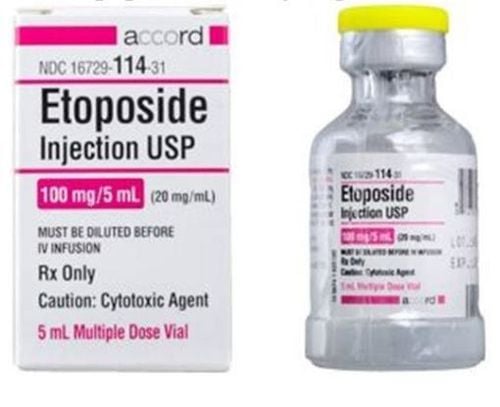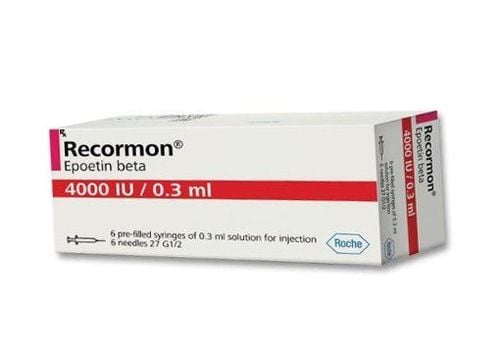This is an automatically translated article.
The article was professionally consulted with Master, Doctor Phan Truc - Internal Oncologist - Vinmec Cancer Center - Vinmec Times City International Hospital.
Multiple myeloma is a rare malignancy characterized by bone pain, pathological fractures, presence of M protein in the blood or urine, and other lesions. So is multiple myeloma curable?
1. What is multiple myeloma?
Multiple myeloma is a cancer of plasma cells that produces monoclonal immunoglobulins that invade and destroy adjacent bone structures. Common manifestations of multiple myeloma include bone pain, kidney failure, recurrent infections, anemia, and hypercalcemia. This malignancy requires the presence of M protein (in blood or urine), combined with osteolytic lesions, urine light chain protein, or excessive plasma cells in the bone marrow. . Therefore, the laboratory examination that is considered an important criterion in the diagnosis is bone marrow biopsy.
The prevalence of multiple myeloma is about 2-4/100,000 population, male/female is about 1.6/1 with average age of about 65. It is interesting that black people have 2 times the risk of developing the disease compared to the average age. White skin-man. Many people wonder if multiple myeloma is hereditary? This is a disease caused by mutations acquired during aging, not inherited. Although the exact cause of the mutation is unknown, several causative factors have been mentioned such as genetic background, radiation or chemical exposure...
2. Mechanism of multiple myeloma
M protein secreted by malignant cells in about 55% of cases is IgG, about 20% is IgA. Of these, about 40% have the presence of Bence Jones protein in the urine (this protein is a kappa or lambda light chain). Along with that, about 15-20% of cases plasma cells only produce Bence Jones protein and only about 1% in the form of IgD. Very rarely, in the absence of protein M in the blood or urine, diagnosis is made by the presence of monoclonal globulins in the blood.
Diffuse osteopenia or development of sporadic osteopenia occurs as a result of widespread malignant plasma cells, bone replacement, or direct secretion of cytokines that activate osteoclasts and inhibit bone formation cell. Increased bone resorption contributes to hypercalcemia.
In many patients, renal failure may be recognized at the time of diagnosis of multiple myeloma or may develop gradually during follow-up and treatment. The causes of renal failure in multiple myeloma are diverse, usually occurring due to the deposition of light chain globulins in the distal convoluted tubule or from excessive hypercalcemia. Anemia is also a common problem, related to kidney failure, due to cancer cells inhibiting red blood cell production or sometimes iron deficiency.
Some patients with multiple myeloma are susceptible to infections, including viral infections (especially Herpes Zoster), which are often associated with the use of immunosuppressive drugs.
3. Symptoms of multiple myeloma
Manifestations of multiple myeloma may include:
Persistent bone pain, especially pain in the back or chest; CKD; Recurrent infections; Pathological fractures are relatively common, including vertebral collapse causing spinal cord compression and hemiplegia; Anemia may predominate in some patients or be the sole reason for the patient to seek medical attention; Syndrome of hyperviscosity; Peripheral neuropathy, carpal tunnel syndrome or abnormal bleeding; Signs of hypercalcemia such as thirst, dehydration...; Enlarged lymph nodes, enlarged liver (less common).
4. Diagnosis of multiple myeloma
Multiple myeloma should be considered in patients over 40 years of age with unexplained bone pain, particularly pain at night or at rest, with other typical symptoms. In addition, multiple myeloma should be considered when laboratory abnormalities are unresolved, such as hyperproteinaemia or proteinuria, hypercalcemia, renal failure, or anemia. Therefore, laboratory tests that should be indicated include routine blood tests, protein electrophoresis, radiographs, and bone marrow tests.
Routine blood tests include complete blood count, erythrocyte sedimentation rate and blood chemistry with the following results:
Anemia occurs in 80% of cases, usually isochromic anemia, pre-chained red blood cells (including red blood cells) composed of 3 to 12 red blood cells arranged in chains). The white blood cell and platelet counts were mostly within normal limits; Elevated erythrocyte sedimentation rate (ESR), usually above 100mm/hr; Serum urea, creatinine, LDH and uric acid may be elevated, the anion gap is sometimes low, and approximately 10% have hypercalcemia. Protein electrophoresis on 24-hour blood and urine samples to ensure that the amount of M protein is sufficient for detection. The presence of M protein on blood electrophoresis is found in about 80-90% of cases, the remaining 10-20% only detects monoclonal light chain globulins (or Bence Jones proteins) and IgD. As for urine protein electrophoresis, the presence of M protein is always present. Immobilized immunosorbent assay assists in the accurate determination of the globulin class of the M protein, commonly IgG and IgA, rarely IgD, IgM or IgE . Quantitative testing of free kappa and lambda light chains in serum supports the diagnosis and can be used for the purpose of monitoring treatment efficacy and disease prognosis. In addition, patients with multiple myeloma should have beta-2 microglobulin measured when the diagnosis is confirmed to determine the disease stage according to the international classification. X-ray examination of bones (including skull, long bones, vertebral column, pelvis, and ribs) may reveal perforated osteolytic lesions or diffuse osteoporosis in most cases. Bone MRI helps identify lesions in more detail than radiographs. PET-CT is an adjunct to help differentiate plasmacytomas from multiple myeloma.
Bone marrow aspiration and biopsy help detect the percentage of plasma cells in the marrow. One criterion for the diagnosis of multiple myeloma is when plasma cells account for more than 10%. Due to the unequal invasion of the bone marrow by malignant cells, leading to some patients with multiple myeloma, the plasma cell count remains less than 10%. However, rarely the plasma cell count in the bone marrow is within normal limits.
Definitive diagnosis and differentiation of multiple myeloma from other malignancies requires a combination of several criteria, including:
Presence of plasma cells in the bone marrow or cytoplasmic tumors; Protein M in serum and/or urine; Organ damage such as hypercalcemia, kidney failure, anemia, or bone damage. In the absence of M protein in the blood, multiple myeloma can be diagnosed when the Bence Jones protein in the urine is more than 300 mg/24 hours or there are abnormal light chain globulins in the blood, bone resorption and plasma cell damage. bone marrow arranged in clusters or bands.
5. What is the prognosis of multiple myeloma?
Many people wonder if multiple myeloma is curable? This malignancy is progressive and cannot be completely cured. However, recently due to the development of treatment, the survival time of patients has been significantly improved over 5 years.
Some poor prognostic factors of multiple myeloma:
Low blood albumin levels and high beta-2 microglobulin levels; Renal failure at the time of diagnosis, unless renal function improves after treatment; Accompanied by some genetic abnormalities increases the risk of bad.
6. Treatment of multiple myeloma
Treatment of multiple myeloma has been gradually improved over the past 10 years, thereby prolonging the patient's survival time with appropriate treatment. Treatments include direct targeting of malignant cells in symptomatic individuals or treatment of organ dysfunction (such as anemia, renal failure, hypercalcemia, or bone damage). Asymptomatic cases of multiple myeloma may not require treatment, instead monitoring until symptoms and complications occur. Patients with osteolytic lesions or bone loss should receive monthly Zoledronic Acid or Pamidronate infusions to minimize bone complications.
6.1. Treatment of Malignant Cells Conventional multiple myeloma chemotherapy includes only oral melphalan and prednisone at 4-6 week intervals and monthly response assessment. More recent studies have shown that the treatment of multiple myeloma seems to be better with , ixazomib or thalidomide.
Other chemotherapy drugs that may include Cyclophosphamide, Bendamustine, Doxorubicin may increase effectiveness when combined with an immunomodulator (such as Thalidomide, Lenalidomide or Pomalidomide) or a Proteasome inhibitor (such as Bortezomib, Ixazomib or Carfilzomib). Many chemotherapy patients get better results when combining drugs with different mechanisms such as Proteasome inhibitors and immunomodulators.
Responds to chemotherapy when the patient relieves bone pain, improves fatigue, decreases blood/urine M protein levels, decreases blood light chain globulin levels, increases red blood cell count, and improves kidney function when present CKD.
Autologous stem cell transplantation is a consideration when patients with multiple myeloma have adequate heart, liver, and kidney function, especially when the disease is stable or responds after several cycles of initial therapy. head. However, recent studies show that modern treatments are highly effective and reduce the need for stem cell transplantation.
In cases of recurrent or persistent multiple myeloma, bortezomib, ixazomib, or carfilzomib can be combined with thalidomide, lenalidomide, or pomalidomide and chemotherapy or corticosteroids. Especially, a completely oral regimen combining Ixazomib, Lenalidomide, Dexamethasone with high efficiency and low toxicity promises to bring convenience to patients, reduce hospitalization costs and reduce side effects for patients treated. treatment of multiple myeloma – a disease that often requires long-term treatment and recurs many times.
Maintenance treatment of multiple myeloma requires replacement of chemotherapy drugs with Interferon Alpha to prolong remission, but survival does not improve and significantly increases side effects. Therefore, if the patient has responded to a corticosteroid-based regimen, maintenance therapy with corticosteroids alone can be considered. In addition, Thalidomide can be effective in maintenance therapy, patients can use Lenalidomide alone or in combination with corticosteroids.
6.2. Treatment of complications Patients with anemia due to inappropriate chemotherapy can be intervened with recombinant Erythropoietin (40,000 IU subcutaneously once a week). If anemia is severe, red blood cell transfusions may be considered. If anemia is caused by iron deficiency, intravenous iron supplementation is necessary. Patients with multiple myeloma with anemia should be periodically checked for iron, transferrin and serum ferritin to monitor the body's iron stores.
Hypercalcemia requires intensive salt flushing, intravenous use of bisphosphonates after rehydration, and sometimes in combination with calcitonin or prednisone.
Hyperuricemia in most cases is not necessary to use Allopurinol. This treatment should only be considered in patients with elevated serum uric acid levels causing increased tumor burden and high risk of treatment-induced tumor lysis syndrome.
Renal failure can be ameliorated by appropriate fluid resuscitation. Dehydration associated with the use of intravenous contrast media may cause acute renal failure in patients with Bence Jones proteinuria.
Chemotherapy-induced leukopenia increases the risk of infection. In addition, the risk of herpes zoster virus infection is higher when people with multiple myeloma are treated with drugs such as bortezomib or carfilzomib. Infectious patients must use antibiotics, but not for prophylactic purposes. Some cases can be prevented with antiviral drugs when using Bortezomib or Carfilzomib.
Bone lesions require a variety of treatments, including calcium and vitamin D supplementation to maintain bone density, pharmacological bone pain relief, and reduced-dose radiotherapy (18-24 Gy).
Document supported by Takeda company.
Please dial HOTLINE for more information or register for an appointment HERE. Download MyVinmec app to make appointments faster and to manage your bookings easily.














